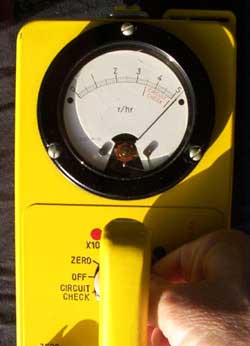 To
cope with the possibility that terrorists might someday
detonate a nuclear bomb on American soil, the federal
government is reviving a scientific art that was lost
after the cold war: fallout analysis. To
cope with the possibility that terrorists might someday
detonate a nuclear bomb on American soil, the federal
government is reviving a scientific art that was lost
after the cold war: fallout analysis.
The goal, officials and weapons experts
both inside and outside the government say, is to figure
out quickly who exploded such a bomb and where the
nuclear material came from. That would clarify the
options for striking back. Officials also hope that if
terrorists know a bomb can be traced, they will be less
likely to try to use one.
In a secretive effort that began five
years ago but whose outlines are just now becoming
known, the government's network of weapons laboratories
is hiring new experts, calling in old-timers, dusting
off data and holding drills to sharpen its ability to do
what is euphemistically known as nuclear attribution or
post-event forensics.
It is also building robots that would
go into an affected area and take radioactive samples,
as well as field stations that would dilute dangerous
material for safe shipment to national laboratories.
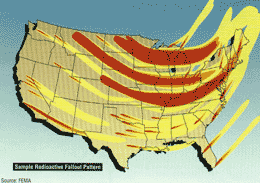 |
| Predicted fallout
developed during cold war. Displays prevailing
wind patterns. |
"Certainly, there's a frightening
aspect in all of this," said Charles B. Richardson, the
project leader for nuclear identification research at
the Sandia National Laboratories in Albuquerque. "But
we're putting all these things together with the hope
that they'll never have to be used."
Most experts say the risk of a
terrorist nuclear attack is low but no longer
unthinkable, given the spread of material and know-how
around the globe.
Dr. Jay C. Davis, a nuclear scientist
who in 1999 helped found the Pentagon's part of the
governmentwide effort, said the precautions would "pay
huge dividends after the event, both in terms of the
ability to identify the bad actor and in terms of
establishing public trust."
In a nuclear crisis, Dr. Davis added,
the identification effort would be vital in "dealing
with the desire for instant gratification through
vengeance."
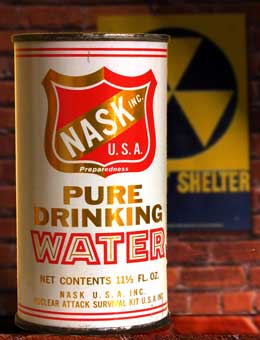 Vice
President Dick Cheney was briefed on the program last
fall, Dr. Davis said. The National Security Council
coordinates the work among a dozen or so federal
agencies. Vice
President Dick Cheney was briefed on the program last
fall, Dr. Davis said. The National Security Council
coordinates the work among a dozen or so federal
agencies.
The basic science relies on faint
clues — tiny bits of radioactive fallout, often
invisible to the eye, that under intense scrutiny can
reveal distinctive signatures. Such wisps of evidence
can help identify an exploded bomb's type and
characteristics, including its country of origin.
Solving the nuclear whodunit could
take much more information, including hard-won law
enforcement clues and good intelligence on foreign
nuclear arms and terrorist groups. For that reason,
several federal agencies are involved in the program,
among them the Department of Homeland Security and the
Federal Bureau of Investigation.
The program addresses true nuclear
weapons as well as so-called dirty bombs, ordinary
explosives that spew radioactive debris.
"It's a very hard job," said William
Happer, a physicist at Princeton who led a panel that
evaluated the identification work.
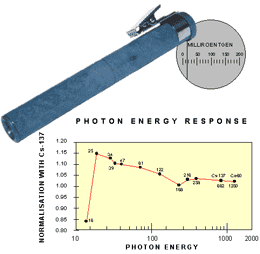 |
| A radiation
dosimeter to monitor your total exposure to your
person. Everyone should have one of these,
although good ones are not cheap. Plan on spending
$200-$300. |
Mr. Happer said he was worried that a
rush for retribution after a nuclear attack might cut
short the time needed for careful analysis. "If we lose
a city," he said, "we might not wait around that long."
The effort to fingerprint domestic
nuclear blasts is part of a larger federal project to
strengthen the nation's overall defenses against
unconventional terrorist threats. Mostly, the goal is
prevention. For instance, the government recently sent
teams of scientists with hidden radiation detectors to
check major American cities for signs that terrorists
might be preparing to detonate radiological bombs.
In contrast, the identification
program seeks to increase the government's knowledge and
options should prevention fail. "We're trying to
resurrect some of our capability," said Reid Worlton, a
retired nuclear scientist from the Los Alamos weapons
laboratory in New Mexico who has been called in to aid
the fallout endeavor. "It sort of died. They're not
doing radiochemistry on nuclear tests anymore, so it's
hard to keep these people around."
The effort draws on work that began at
the dawn of the atomic era. Scientists working on the
Manhattan Project built an array of devices to monitor
nuclear blasts in the New Mexico desert in July 1945 and
at Hiroshima and Nagasaki a month later. The experience
helped scientists learn what to look for.
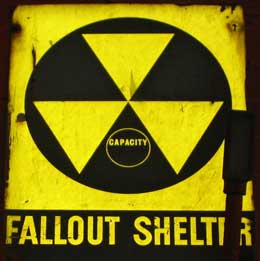 The
first hunt zeroed in on the Soviet Union. In the late
1940's, military weather planes used paper filters to
gather dust particles around the periphery of Russia,
and scientists in the United States who analyzed the
data at first sounded dozens of false alarms, said
Jeffrey T. Richelson, an intelligence expert in
Washington. The
first hunt zeroed in on the Soviet Union. In the late
1940's, military weather planes used paper filters to
gather dust particles around the periphery of Russia,
and scientists in the United States who analyzed the
data at first sounded dozens of false alarms, said
Jeffrey T. Richelson, an intelligence expert in
Washington.
Then, on Sept. 3, 1949, a weather
plane flying from Japan to Alaska picked up a slew of
atomic particles. "That was the real thing," Mr.
Richelson said. Twenty days later, President Harry S.
Truman announced that the Soviets had exploded their
first nuclear device.
The ranks of fallout investigators
swelled during the cold war as foreign nations conducted
hundreds of atmospheric nuclear tests. By all accounts,
the sleuths made many important discoveries about the
nature and design of foreign nuclear arms.
In time, the ranks dwindled as more
and more nations decided to move their test explosions
underground, eliminating fallout. The last nuclear blast
to pummel the earth's atmosphere was in 1980, and the
last known underground test, conducted by Pakistan, was
in 1998.
As the terrorist threat rose in the
1990's, the government began to consider the quandary
that would arise if a nuclear weapon exploded on
American soil. In 1999, Dr. Davis, then head of the
Defense Threat Reduction Agency at the Pentagon, began
an effort to address the identification problem by
financing research at the nation's weapons laboratories,
many of them run by the Energy Department.
The first money came in late 2000, Dr.
Davis said, and the attacks of September 2001 "made it
clear that a very organized event on a large scale was
credible." That perception, he said, helped the effort
expand.
The secretive work won rare public
praise in a June 2002 report ("Making the Nation Safer")
from the National Research Council of the National
Academies, the country's leading scientific advisory
group. Having the ability to find out who launched a
domestic nuclear strike, the report said, could deter
attackers and bolster threats of retaliation. The report
urged that the program go into operation "as quickly as
practical" and that the government publicly declare its
existence.
Since then, weapons laboratories and
other federal agencies have worked hard on the problem.
"They're making progress but they've got a ways to go,"
said Mr. Worlton, the retired Los Alamos scientist.
In a drill this year, dozens of
federal experts in fallout analysis met at the Sandia
laboratories in Albuquerque to study a simulated
terrorist nuclear blast. Mr. Worlton said they were
broken into teams and given radiological data from two
old American nuclear tests, whose identities remained
hidden, and were instructed to try to name them. Some
teams succeeded, he said.
Mr. Richardson of Sandia said the
laboratory was developing a land robot that could roll
up to 10 miles to sample fallout and return it to human
operators for analysis. It could also radio back some
results if it became stuck. Mr. Richardson said the
robots, now in development, are to be ready in a couple
of years.
Experts say a new aircraft for
atmospheric sampling of nuclear fallout is also in
development. The Air Force currently has one, the
WC-135W Constant Phoenix, for such work. It was first
deployed in 1965.
Weapons experts say getting samples
fast is important because some radioactive debris can
decay rapidly. If captured quickly, they can shed light
on a weapon's design.
One way of trying to identify a bomb's
origin positively, several experts say, is to match
debris signatures with libraries of classified data
about nuclear arms around the world, including old
fallout signatures and more direct intelligence about
bomb types, characteristics and construction materials.
"If you're talking about a stolen
device, you might try to do that," Mr. Richardson said.
"But if it's improvised, that's less likely to work. It
might not look like things you've seen before."
A further complication is that even
knowing who made a bomb may say little about who
detonated it. In a 1991 Tom Clancy novel, "The Sum of
All Fears," Islamic terrorists find and rebuild an
Israeli nuclear weapon and set it off at the Super Bowl.
Federal experts say complex threat
scenarios (for instance, an American warhead being
stolen and detonated in an American city) mean that many
types of intelligence might be needed for successful
identification. Over all, it is unclear how much money
the government is spending on the effort.
Private experts offered suggestions
for improvement. Dr. Happer of Princeton, who heads a
university board that helps oversee campus research,
said the program might be cooperating too little with
nuclear allies. "It's to our advantage," he said, "for
all of us to share."
Dr. Davis, the former head of the
Defense Threat Reduction Agency, made several policy
recommendations last April in an article for The Journal
of Homeland Security. He said the F.B.I. should lead the
program, presidentially appointed overseers should guide
it, goals should be set for how long analyses should
take and legal issues of prosecution should be examined.
In an interview, Dr. Davis said his
suggestions had made little headway, partly because of
the topic's grisly nature. "This is an ugly subject
because your best effort is going to be barely
adequate," he said. "That's not the kind of phrase
people like to hear."
Mr. Richardson of Sandia said that the
attribution effort had made good technical progress and
had already some ability to identify an attacker.
"We're hoping for deterrence," he
said. "We don't want anybody to think they can get away
with it."
See my
Radiation Detection info page
|